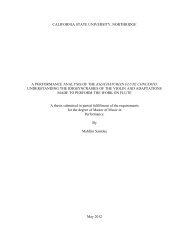2644 - CSUN ScholarWorks - California State University, Northridge
2644 - CSUN ScholarWorks - California State University, Northridge
2644 - CSUN ScholarWorks - California State University, Northridge
Create successful ePaper yourself
Turn your PDF publications into a flip-book with our unique Google optimized e-Paper software.
86 · journal of Student Research Abstracts<br />
2839<br />
HOW SEA ANEMONES DISTINGUISH POSSIBLE FOOD SOURCES.<br />
J.M. Robbins, K.J. Ector and S. Engelmann (teacher). Palisades Charter High School, 15777 Bowdoin St.,<br />
Pacific Palisades, CA 90272.<br />
This study examined the question of how sea anemones distinguish possible food sources, organic from<br />
inorganic substances. Seven sea anemones of various sizes were offered five different organic substances, such<br />
as plastic, Styrofoam, glass, shell, and a copper penny. The objects were drifted by the anemone and allowed<br />
to brush the tentacles. If the tentacles attached to the object, it was considered accepted. The acceptance or<br />
rejection rate was mostly random, although the Styrofoam was rejected by them all. The penny had an acceptance<br />
rate of 29%, the shell had an acceptance rate of 14%, the plastic had an acceptance rate of 29%, and the<br />
seaglass had an acceptance rate of 14%. From these results we can conclude that the sense of texture must play<br />
an important factor in whether or not a potential food source is accepted or rejected.<br />
2840<br />
EFFECTS OF KNOWLEDGE OF PRIOR ACTIONS ON FORMATION<br />
OF STRATEGY.<br />
Joseph M. Dale and Stephen DeGusta (teacher). John F. Kennedy High School, 6715 Gloria Drive,<br />
Sacramento, CA 95831.<br />
I devised a simple game for two players in which one player attempts to predict a number to be guessed by<br />
his opponent. If he is successful, he again tries to predict a number guessed by his opponent. If he is unsuccessful,<br />
he guesses a number which his opponent attempts to predict. Each player should attempt to develop a<br />
strategy which will enable him to always predict his opponent's guess, and guess a number which his opponent<br />
will not be able to predict. In the experimental group, I provided one player in each pair with a written<br />
record of his prior guesses and predictions, his opponent's prior guesses and predictions, and who, he or his<br />
opponent, won each game. His opponent had no such information. In the control group, neither player had<br />
information. I attempted to determine whether the player with more information would be able to win more<br />
often than if he had no such information, by forming a successful strategy. For reasons beyond my control, I<br />
collected much less data than I had planned to collect. From the data collected, I concluded that there was no<br />
significant difference (X 2 = 0.371, 0.057; 0.5 < p < 0.9) between the number of games won by players who had<br />
information (while their opponents did not) and players who did not have information (and whose opponents<br />
also had no information). However, I have identified several factors in my experimental setup and in the execution<br />
of the game which may suggest that this conclusion is invalid.<br />
2841<br />
THE EFFECTS OF INCREASING WATER ON BEACH EROSION.<br />
Gary Chu, Walter Yuen and Steve DeGusta (teacher). John F. Kennedy High School, 6715 Gloria Drive,<br />
Sacramento, CA 95831.<br />
The purpose of this experiment was to see the effect of increasing water on beach erosion. A wave tank with<br />
a wave maker was built for this experiment. Two thousand milliliters of sand was placed on the opposite end<br />
of the wave maker in the tank at a sloped angle to simulate a beach and then five thousand milliliters of water<br />
was added into the tank. After running the wave machine and taking note on how much sand was displaced<br />
and the change in beach profile, 10 percent more water (500 ml) was added into the tank and the wave machine<br />
was used again. Comparisons were made between the control group and test group beach profiles and the volume<br />
of sand lost when the water was increased. The change in volume of sand showed that the beach was<br />
changed significantly and the t-test verified this (t=22.13, p













